modern tennis methods
what is MODERN TENNIS?
MODERN TENNIS is possibly not even a thing at the end of the day, since the very definition of the word ‘modern’ would overlook the fact these techniques and ideas have been around for as long as tennis itself and virtually all other athletic endeavour.
Angular Momentum as a source of power, has long been associated with activities and sports that involve throwing or hitting something. The power comes from the rotation of the upper body and the kinetic chain, with the bodyweight moving from one leg to the other as the body unwinds.
The Linear Power of traditional tennis, also has upper body rotation and the bodyweight moving from one leg to the other, but that movement must be in a forward direction – a luxury of space and time that the modern game will often not allow.
Just try hitting a forehand that’s shoulder height or above; first sideways-on, then face-on, and you will clearly feel why things needed to evolve. Or, try hitting a ball coming at you so fast you don’t have the space or time to move.
On the professional tour, Borg and Vilas were the pioneers of the modern game takeover back in the early 70’s, as it began to breakthrough into the mainstream. Over the next sixty years this style of play would become the only show in town.
Basically all the tennis you see on TV these days is Modern Tennis. A style of play that involves hitting higher over the net with more topspin; more open and semi-open stances, and more western and semi-western grips.
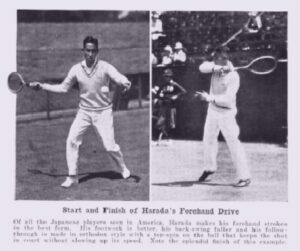
Japan’s Takeichi Harada, 1920’s – open-stance forehand with window wiper finish
The traditional game of the past was more about hitting the ball flatter and lower, with slice or side-spin as the spins of choice. Closed stances and Eastern grips made this a whole lot easier. The equipment played a large part in this – wooden rackets and pressure-less balls that came in boxes.
When it comes to instruction, in general, traditional coaching methods tend to overload the student with lists of instructions for numerous body parts from the start.
A lesson with me will focus on the hand from the start, knowing that the body will facilitate what the hand is trying to do, in the same way we move to catch a ball or open a door.
The growth of the Modern Tennis movement in coaching has been very slow in many countries, yet relentlessly brought forth by the advancing technology – balls are much faster, more sensitive to spin and bounce higher, while rackets are more powerful and manoeuvrable. String technology also brings another dimension of power and spin to matters.
In a nutshell Modern Tennis is focused on the hand and later angular momentum, which bring with them – more natural and flexible footwork, more open and semi-open stances, more western and semi-western grips, and more topspin.
is it actually MODERN?
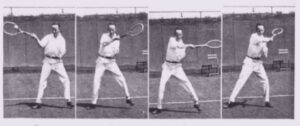
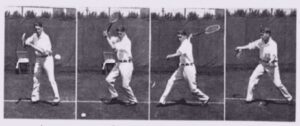
As you can clearly see in the photo’s the open-stance forehand has been around since the very beginning of tennis.
The best players have always played spontaneously and moved naturally to the ball, doing whatever is necessary with the feet and body to impose themselves on the ball.
Over time this has led to an increasing amount of open-stance at higher levels as the game got faster and the bounce got higher, defying the rigid closed-stance dogma that has filled many coaching manuals for the last century.
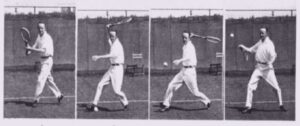
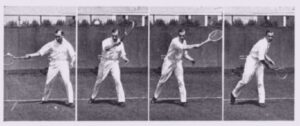
The comfy slacks and huge back-swings may have thankfully slipped into obscurity but the versatility of the open stance has well and truly stood the test of time.
Unfortunately, while the pro game continued to move in this direction, the tennis students of the world have been literally closed off to this vital information, turned sideways to the net in their very first lesson and held there until they discover other possibilities by chance or out of necessity.
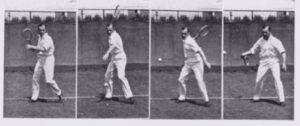
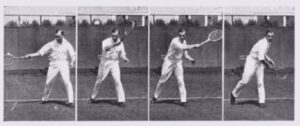
Somewhere along the way tennis teaching got rather stuck, over-complicated and left-brained in many countries, as the experts of the past dissected the game into a rather mechanical checklist that the whole body must memorize and synchronize – a ‘hand-eye-feet-hips-knees-head-shoulders… conundrum’, as opposed to the much simpler ‘hand-eye coordination’ game it can also be.
And thus… many people trying to learn and teach the game have been left feeling rather overwhelmed, confused or uncoordinated in the process.
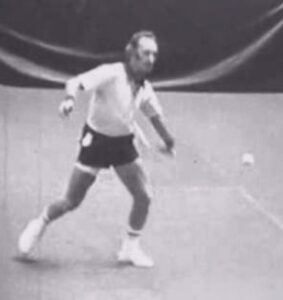
Rod Laver – open-stance forehand
Fortunately, help has always been close at hand, in the form of a man named Oscar Wegner. Back in 1968 Oscar made a crucial observation that tennis was being taught one way while the pros played in an entirely different way.
He began developing a simple teaching methodology that finally made tennis an easy sport to learn. Originally known as ‘The Wegner Method’ these ideas and techniques went on to form the foundations of what became known as Modern Tennis.
Spain, South America, France and Russia were the first to benefit from Oscar’s teachings back in the 1970’s, 80’s and 90’s, as he took his methods around the world.
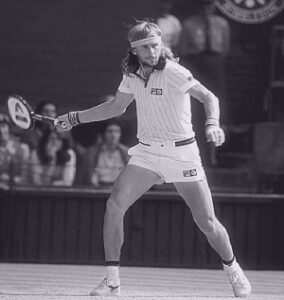
Björn Borg – open-stance forehand
more from OSCAR
“The Spanish Tennis Federation hired me in 1973 to coach the top juniors at the National Tennis School. I applied these same fundamentals, despite some opposition from leading Spanish coaches, with astounding results…
…The coaches accepted the evidence and adopted my methods. From then on, Spain didn’t have just a few winners – it had a crowd of them, an influx of new talent that continues to this day!”
“In the 1980’s I was invited to Brazil, where I spent half that decade coaching in a small club and teaching local pros my coaching methods. Two juniors whom I coached went on to win the Junior Davis Cup in Miami in 1993. Some years later one of them Gustavo “Guga” Kuerten went on to win three French Open championships and became the World Champion in 2000″
“The Russian Tennis Federation, which has worked with my first book since 1990, implemented my techniques in their junior programs, and the results are showing up in the professional ranks…”
“In 1994, I became the tennis commentator for ESPN Latin America, changing the entire continents coaching ideas and methods…ESPN International broadcast my tips in English and Spanish to over 150 countries, initiating a coaching revolution around the world.”
“An ambitious tennis father, Richard Williams, saw these shows and trained his young girls on my system for four years before sending them directly onto the professional tour, A few years later Venus and Serena Williams dominated the sport.”
“Another tennis parent, this one in Thailand, had a youngster with the talent to become a pro, but very little tennis was being played in the country and even less coaching material were available. When he saw the ESPN broadcasts, he ordered my videos to coach his son. Within a few years, Paradorn Srichapan became one of the top players in the world.”
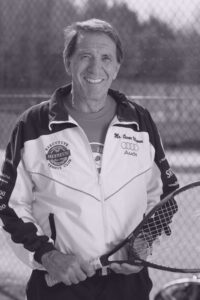
Forty years on, whether we like it or not, the whole professional tour is playing tennis this way, and Oscar is considered by many to be ‘the father of Modern Tennis’.
Venus and Serena Williams, Gustavo Kuerten, Björn Borg, Marat Safin and Paradorn Srichapan are just a few individual success stories, to hold up alongside the ongoing national success of the countries and continents mentioned above.
The list is impressive and ongoing, and the good news is.. you don’t need the hand-eye skills of a pro to get it!
Even if you have previously thought of yourself as being uncoordinated and tennis as a difficult game to learn, you might be surprised just how easy it can be.
Do the pros hit open stance because they are just better…?
Are these advanced manoeuvres that beginners should learn down the road somewhere…?
Definitely not! I feel like the pros might possibly hit a little more closed stance if the bounce, space and time allowed them to, even though many don’t, even in a relaxed warm-up – see video on player’s page. In reality they are being pushed to their limits by a fellow professional and must resort to mostly open stance to save time, steps and energy.
If you transfer this inevitability and logic down to beginners, or less fit or trained individuals – who will also be playing near their limits, then the need for the versatility of an open natural stance is there from the very start.
Following are a few long-standing teaching myths held up against the modern way of doing things.
traditional
teaching
myths
V
modern
tennis
facts
myth
Tennis is a game of specific steps, positions and preparations, that must be studied in detail.
fact
Tennis is a game where you move to the ball naturally and instinctively, as if you were moving to catch it, focusing only on what you do with the hand, and the racket. A typical tennis stroke is a channelled effort, rather than a series of specific thoughts and actions, with the focus on the feeling of the stroke and the finish rather than complicated mechanics. The feet and the body will move naturally and harmoniously towards the same moment if you let them.
myth
Take your racket back early, quickly, or as soon as you see the ball leave the opponent’s racket.
fact
Restrain yourself from swinging too early or too quickly. Prepare the grip, and set the structure of the hitting arm early, but keep the racket out in front of you until the ball is close. This will help you to find the ball and make the desired contact more easily. You want to feel like you are stalking the ball with your racket face, until you can almost touch it. Most professionals do not swing until the ball is bouncing or later.
myth
Put your opposing foot across the body for your final step and turn sideways when you hit a forehand (closed stance).
fact
Using an open stance on the forehand, will result in more power and a more natural shot. Most formal lessons will still have you turning sideways to the ball (linear power), while the greatest forehands in the game these days are played facing the net with a semi or open-stance (angular momentum). This will also add some flexibility to the set up.
myth
Imagine you are hitting through three or four tennis balls and follow through towards the target.
fact
Brush up the back of the ball in a window wiper motion. This old myth will have you hitting like a baseball player, home runs and all. Better to feel your hand/racket face brush across the back of the ball as much as possible until you are a Jedi and then add some more racket head speed and forward intentions.
myth
Follow through towards the target.
fact
The ball will go where your hand is facing. The follow-through on a ground-stroke striking a similar height ball will come across the body in nearly the same way. It’s the angle of the hand through contact that will determine the direction. On the volley the same thing – the angle of the hand changes while the short punching motion stays virtually the same.
modern tennis methodology
coaches association
“MTM is a teaching system that makes one aware of the most efficient and most natural mechanics in the game at both the physical and physiological levels, in conjunction with one’s feel and instinct, and how to explore them to bring about one’s own idiosyncratic, perfect game”
the goal of the mtmca
“The purpose of MTMCA is to make available to the masses a tennis teaching methodology that, when applied diligently, will result in a greater sense of ability and enthusiasm for this wonderful sport. MTMCA seeks to achieve its purpose with resoluteness, determination and a vision of clarity, good will and kindness, intended to help people play a better game”